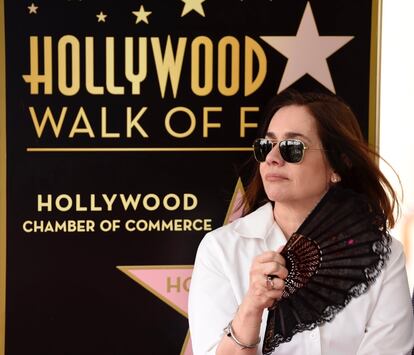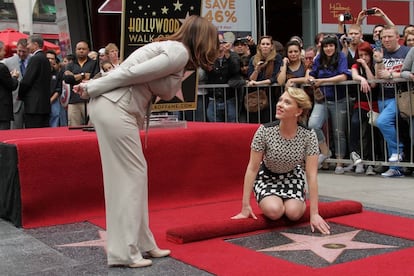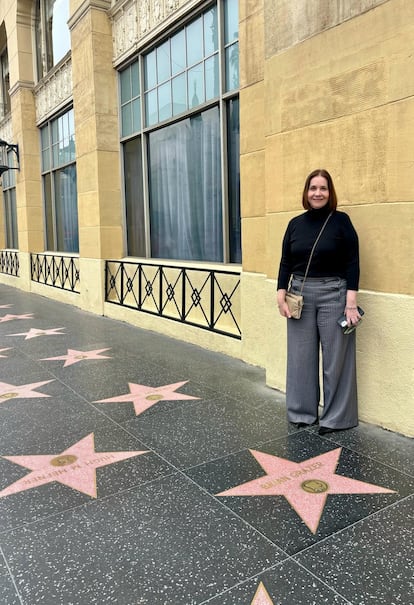Ana Martínez, the Latina behind the stars on the Hollywood Walk of Fame
The daughter of a Peruvian father and a Mexican mother, the vice president of Media Relations for the Hollywood Chamber of Commerce is the ultimate authority when it comes to giving out marble stars to celebrities


Strolling with Ana Martínez along the Walk of Fame, the heart of Hollywood and the most visited point in the city of Los Angeles, is a revealing experience. With her, the terrazzo stars — colored gray and pink, with gold edges — look different. Perhaps because she’s the one who chose them and placed them there. Not with her hands per se, but through her work.
For the past 36 years, she’s been the producer and vice president of Media Relations for the Hollywood Chamber of Commerce. This is the highest authority when it comes to granting these status symbols, which are the most recognizable in the city (after the Hollywood Sign, of course). Incidentally, the Chamber — and, therefore, Martínez — are also responsible for the nine famous white letters on the hills.
Born in Los Angeles, the daughter of a Peruvian father and a Mexican mother, she started off as a secretary in the Chamber. Today, however, she’s the one who answers the phone when the stars call, looking for stars of their own.
Martínez has a job that she loves. At 62-years-old — and with almost 40 years of experience in the entertainment world — she doesn’t intend to give it up for at least five more years. She doesn’t lack enthusiasm or energy in the slightest, but if there’s one downside to her job, it’s the fact that “it consumes you,” she sighs. “It’s 24 hours a day.”
This is because she’s the person who receives the more than 200 annual applications, precisely at this time of year, in the spring, when they open the season. She manages them, accumulates the documentation and presents them to the president and CEO, along with more than 40 members of the Hollywood Chamber of Commerce, who vote on whether or not a candidate deserves a star. Every year, around 30 are granted, which means that around 30 annual ceremonies are held in the heart of Hollywood Boulevard, one of the busiest streets in the city. Martínez is also in charge of organizing these ceremonies, checking the star, making sure that the police are prepared, that the press is summoned, that the sponsors are in place… and that the fans are going crazy.
Martínez reveals many of the stars’ secrets but also acknowledges — with a tired smile — that there are limits regarding what she can do about who has their name engraved in gold on the Boulevard and who doesn’t. In the perfect Spanglish that she has mastered in the city, she tells EL PAÍS how the process works. First, the celebrity in question has to be nominated. Anyone can do this: a fan club, a friend, one of their managers, whoever. Oftentimes, it’s Martínez herself who calls their agents, or meets with the big studios to offer someone the nomination. They have to fill out an official form and pay $250. Of course, the person being nominated has to accept the nomination. “It’s the so-called Springsteen Policy, effectively,” she laughs. Indeed, it comes from Bruce Springsteen: he was the first person who — when already nominated and in the process of acceptance — raised his voice and refused to receive the star. Hence, the celebrity’s prior approval is now required.

“I don’t know why he didn’t want it,” Martínez admits. “Neither did Clint Eastwood nor Julia Roberts…” Doesn’t Roberts — America’s Sweetheart — have a star among the more than 2,700 on the Hollywood Walk of Fame? Well no, the procedures began but everything fell by the wayside, Martínez admits. She would love to give it to Roberts in person: she even has a very clear idea of where it would be. “I’m saving her the only space left in [front of] the Chinese Theater,” she reveals. That is, if she accepts it. She would be in the Motion Pictures category, but there are five more: Television, Recording, Radio and Live Performance, plus a new one: Sports Entertainment.
Following the nominations, the selections are made. Then, a fee needs to be paid. This cost of $75,000 is usually covered by the record companies, movie studios and streaming platforms affiliated with the individual who’s receiving the honor. “That money usually goes into a trust — a fund set up to repair and maintain the stars,” Martínez notes. This also pays for the costs of the ceremony.
It’s Martínez who chooses where the star will be installed. For example, when there are romantic couples being honored, she wants them to be together, like Penélope Cruz and Javier Bardem: their stars are at the door of the El Capitan Theater. She also picks the day of the ceremony, which takes place at 11:30 in the morning. Each one of these ceremonies takes between two and three months to prepare. There are some months when the vice president has held up to four in a single month — one per week. They’re all broadcast live, the latest having been held for Lenny Kravitz, Gwen Stefani, Dr. Dre and Marc Anthony, among others. All of them are accompanied by exceptional sponsors, from their children to other artists.
“It’s an event that attracts a lot of money: there are people who travel to see their idols, there are flights, shopping, restaurants,” Martínez details. In November 1998, legendary Mexican singer Vicente Fernández kissed his star in front of more than 4,000 fans. Martínez remembers it perfectly, and it also surprised her to see the Boulevard flooded with followers who brought their own music and food. Only the Mexican singer Selena Quintanilla broke that attendance record, with 4,500 people showing up at the inauguration of her star in November 2017, when 22 years had passed since her death. Beginning in the second year after an artist’s death, a star can be awarded posthumously.
Afterward, the star stays in place forever. You don’t have to pay an annual fee or anything like that. At the moment, the Chamber of Commerce has never removed any, although there are certain critical voices that demand removing Donald Trump’s. Ana Martínez is discreet about it, but she suggests that it would be hasty to make such a decision, despite the fact that there’s immense pressure from powerful groups within the city of Los Angeles that have been asking for it for some years. In fact, the City Council is one of the main interlocutors of the Chamber of Commerce. The two bodies have shared responsibilities, such as providing cleaning and maintenance, or deciding where to place the stars (for instance, they’re not allowed to be in front of bus stops).
The Hollywood sign is another shared responsibility. Martínez says that it’s very protected and that it’s difficult to hold events around it. They only keep it up-to-date and paint it white from time to time. With the new mayor — Karen Bass — protection is even greater. For example, you cannot walk up to the sign, nor can it even be illuminated at night, something that many tourists are surprised by. The residents of the neighborhoods around it are afraid that the streets will become saturated, or that the sign will catch fire or collapse and the emergency services won’t be able to access them.

After so many years of working in the entertainment sector, little remains of that proverbial shyness that initially plagued Martínez, who started out working at McDonald’s and clothing stores, before interning on the television show The Price is Right. Then, she saw an ad in Variety: the Chamber was looking for a receptionist.
“I was very shy, I had just left university. Two years later, the previous producer left and they suggested that I apply for the position. I didn’t think I would…” she recalls, still surprised by the circumstances of life, which lead her to cross paths with some of the most famous people in the world every 10 days. She has become one of the most powerful women and Latinas in the global entertainment industry.
For years, Martínez didn’t even want an assistant. “I’ve had a girl working part-time for two years, technology is difficult for me,” she admits. She also remembers how her daughters — who are now in their twenties — used to be a little embarrassed when they explained to their friends what exactly their mother did.
To this day, she continues dreaming of stars. When asked who she’d most like to have, she blurts out — without hesitation — “Adele. And Taylor Swift, too.” And maybe Julia Roberts, if it pleases her.
Sign up for our weekly newsletter to get more English-language news coverage from EL PAÍS USA Edition
Tu suscripción se está usando en otro dispositivo
¿Quieres añadir otro usuario a tu suscripción?
Si continúas leyendo en este dispositivo, no se podrá leer en el otro.
FlechaTu suscripción se está usando en otro dispositivo y solo puedes acceder a EL PAÍS desde un dispositivo a la vez.
Si quieres compartir tu cuenta, cambia tu suscripción a la modalidad Premium, así podrás añadir otro usuario. Cada uno accederá con su propia cuenta de email, lo que os permitirá personalizar vuestra experiencia en EL PAÍS.
¿Tienes una suscripción de empresa? Accede aquí para contratar más cuentas.
En el caso de no saber quién está usando tu cuenta, te recomendamos cambiar tu contraseña aquí.
Si decides continuar compartiendo tu cuenta, este mensaje se mostrará en tu dispositivo y en el de la otra persona que está usando tu cuenta de forma indefinida, afectando a tu experiencia de lectura. Puedes consultar aquí los términos y condiciones de la suscripción digital.
More information
Archived In
Últimas noticias
Most viewed
- Sinaloa Cartel war is taking its toll on Los Chapitos
- Reinhard Genzel, Nobel laureate in physics: ‘One-minute videos will never give you the truth’
- Oona Chaplin: ‘I told James Cameron that I was living in a treehouse and starting a permaculture project with a friend’
- Why the price of coffee has skyrocketed: from Brazilian plantations to specialty coffee houses
- David King, chemist: ‘There are scientists studying how to cool the planet; nobody should stop these experiments from happening’










































